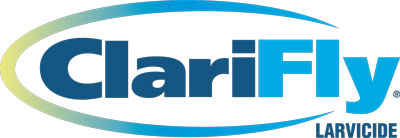
Understanding how to control flies on livestock begins with understanding the pest’s life cycle. House flies move from animal to animal, causing irritation and spreading diseases. Controlling house flies through a combination of strategies and products keeps your animals comfortable and helps prevent common health effects and diseases in livestock. Implementing a proactive, integrated pest management (IPM) program incorporating ClariFly® Larvicide and Starbar® Baits will help prevent house fly populations from rapid growth.
House flies are a vector of disease and an irritant to cattle on a dairy operation, as well as to the people that work on the operation. Because of the confined nature of a dairy, it is important that ClariFly® Larvicide is part of an IPM program for effectively controlling fly populations.
How to identify house flies
- Non-metallic dull grayish color
- Four distinct stripes on the thorax
- Pale yellowish abdomen
The house fly can be found where it feeds — on human food, animal waste, and garbage. This pest breeds quickly and efficiently, with females depositing up to 150 eggs at a time. Because of this, populations can increase dramatically in a short period.
Health effects and diseases from house flies
While the house fly is not a biting pest, it also poses a threat to the bottom line of a dairy operation. House flies spread diseases, including pinkeye and mastitis. Given the role flies play in cow health, implementing proper practices and preventative fly control strategies is key to protecting dairy cows from flies.
House flies are common on cattle feedlots, and populations of these nuisance pests can quickly explode without a proper fly management program in place. House flies breed quickly and lay eggs in cow manure and other areas on your operation. This fly spreads more than 65 diseases to cows, including mastitis, pinkeye, and Bovine Respiratory Disease (BRD), making producers more motivated to think about fly control on dairy operations.
Worker impact
Flies can be a nuisance to human workers on a dairy and can interrupt productivity. In worst-case scenarios, they can potentially even lead to faster turnover among workers.
Managing adult flies on an operation can also require manpower that could be better spent on the dairy. To most effectively and efficiently control flies on a dairy operation, consider a comprehensive fly control program built on ClariFly® Larvicide.
How ClariFly® Larvicide can help
ClariFly® Larvicide is a feed-through fly control solution that relies on the cows to pass the product through manure, requiring no additional effort by workers. And because its unique mode of action targets flies at the larval stage, it prevents adult flies from emerging and needing to be controlled.
While the cost of fly control may require an initial added expense to the bottom line, the long-term savings it can provide to a dairy operation can easily offset the cost. To keep below the economic threshold for flies on dairy cows and maximize the efficiency of your cows and workers, consider fly control an investment rather than an expense.
Protect your dairy cows from harmful flies by implementing ClariFly® Larvicide into your cow’s feed to ensure continuous fly control. Visit CentralFlyControl.com to find a sales representative near you to discuss how to implement ClariFly® Larvicide into your mineral supplement.
